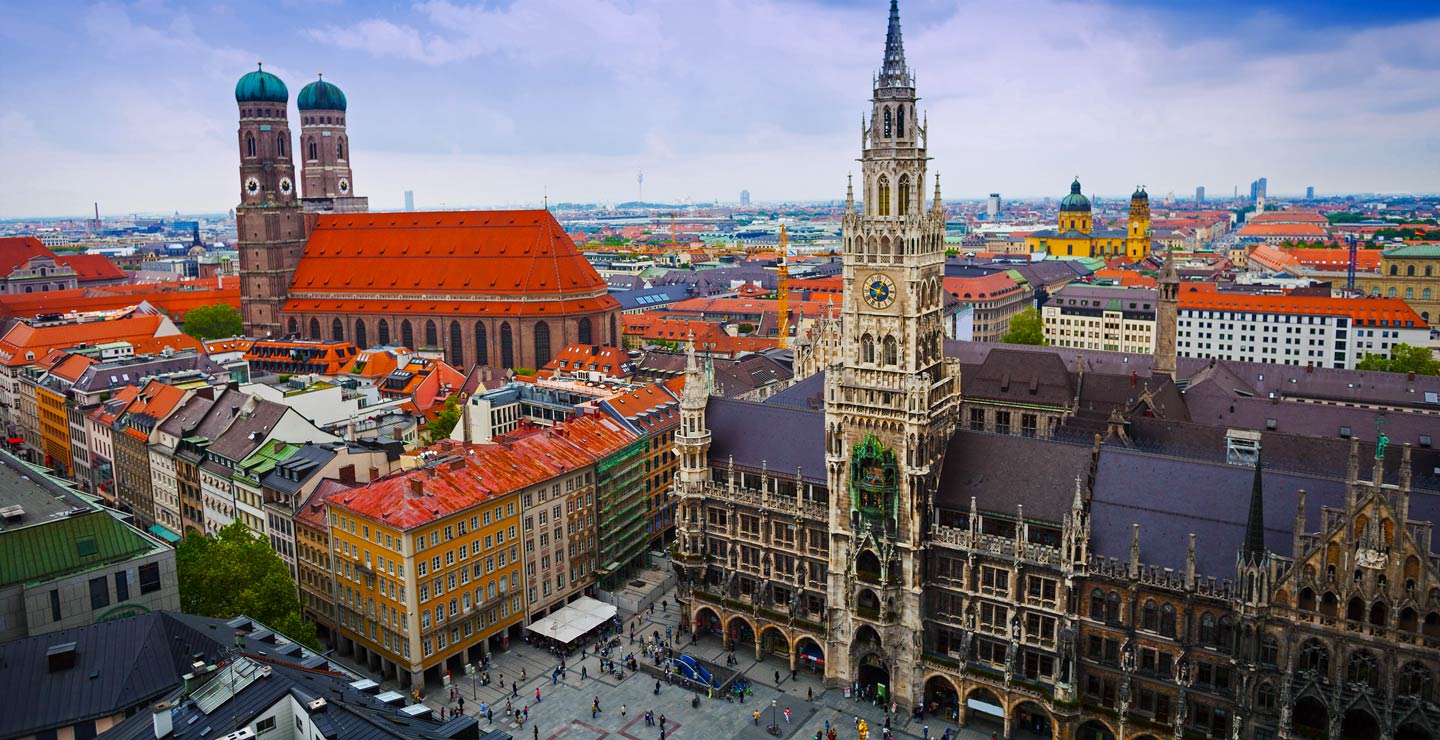Munich, the city that hosts Oktoberfest, is the capital of the region of Bavaria and the third-largest city in Germany. It is located in the south of the country, with Nuremburg to the north and the Austrian border to the south. Visitors can travel by train to Munich from Frankfurt in 6h18mins, and a train journey to Munich from Berlin takes 6h12mins. The station has good connections to other cities in Germany, as well as other European destinations, and the station is served by the Deutsche Bahn Inter-City Express service. Visitors arriving in Munich by train will find themselves in the city centre, close to Marienplatz, in one of Germany’s largest railway stations.
Visiting Munich
To start with the famous Glockenspiel in Marienplatz, visitors should head east on foot from Munich train station, walking for 15 minutes. Here, they can admire the famous performance of colourful figurines dancing, jousting and twirling. The 12-minute performance, representing Munich’s history, takes place daily at 11am and noon. The New Town Hall is also in Marienplatz, but many mistake it for the Old Town Hall because it is an intricate and ornate Gothic building, dating back to the 19th century. The Old Town Hall is a more colourful and picturesque structure, built in the late 15th century. Visitors can take a trip to the top of the tower for great views over the city.
Munich’s museum district is another must-visit for those wanting to explore the city. All it takes is a 20-minute walk north-west from the station. The Kunstareal (art) district includes the Alte Pinakothek, the Neue Pinakothek, and the Pinakothek der Moderne, covering classical, Impressionist, modern and contemporary collections of art, amongst others. As if that wasn’t enough art and culture for one day, the cluster includes even more museums!
There are plenty of places to eat in Munich, whether visitors are looking for a quick bite or a sophisticated sit-down dinner. But, for atmosphere and tradition, heading back towards Marienplatz is a popular option. Here, there are lots of chances to sample the city’s emblematic Weisswurst (white sausage), which should, of course, be accompanied by Weissbier Bavarian wheat beer! Visitors who are in the city for the legendary Oktoberfest will, undoubtedly, have endless opportunities to sample more of the 40 types and 4,000 brands of Bavarian beer.
What to see in Munich
Oktoberfest is full on. At any other time of year, the sheer size of the empty space that would be filled with beer tents and funfair rides is just jaw-droppingly huge. But visiting outside of that peak September to early October peak period means you’ll have more space to savour this delightful Bavarian city and more chance of getting a seat with your beer.
Begin your wander in the heart of the city in Karlsplatz, known more commonly to the locals as Stachus. Walk under Karlstor, one of the old city gates, and along the pedestrianized Neuhauser Strasse. You’ll soon arrive at Marienplatz, the city’s most famous square and where you’ll see the Rathaus. Time your visit for 11 am or noon to see the clock’s figurines do their little routine. Just inside the entrance, there are plaques for each of the city’s twin towns, one of which is our own Edinburgh. It’s also the place to locate the tourist office if you need a map or ideas. Market stalls selling trinkets, flowers and of course food are plentiful in the old town.
If you feel the need for fresh air and vegetation, then Munich has plenty. The one to visit if your time is short is the Englischer Garten. Larger than either Hyde Park in London or Central Park in New York, this sprawling green space was commissioned in 1789 and designed by American Benjamin Thompson. The folly that is the Chinesischer Turm (Chinese Tower) has a beer garden in front of it and reflected the European craze for the Orient when it was built. More recently, a Japanese tea-house has been added.
Adrenaline junkies are even catered for in this playful city. If surfing is your preferred leisure time pursuit, then head down to the icy River Isar with your board and try your luck in the waves that form naturally next to the bridge. Spectators are welcome; in fact, they’re a good way of knowing that you’ve found the right spot. Don’t join the crowd on the bridge itself, potter down to the water’s edge to see for yourself the thrills – and spills.
How to get to Munich by train
Munich is connected not only to other German cities by train but also cross-border services into Italy and Austria. The Bayern-ticket is not only valid for Bavaria as its name suggests, but also the first station across the border, meaning you can use it to visit Salzburg or Kufstein for a day without the need to hire a car

